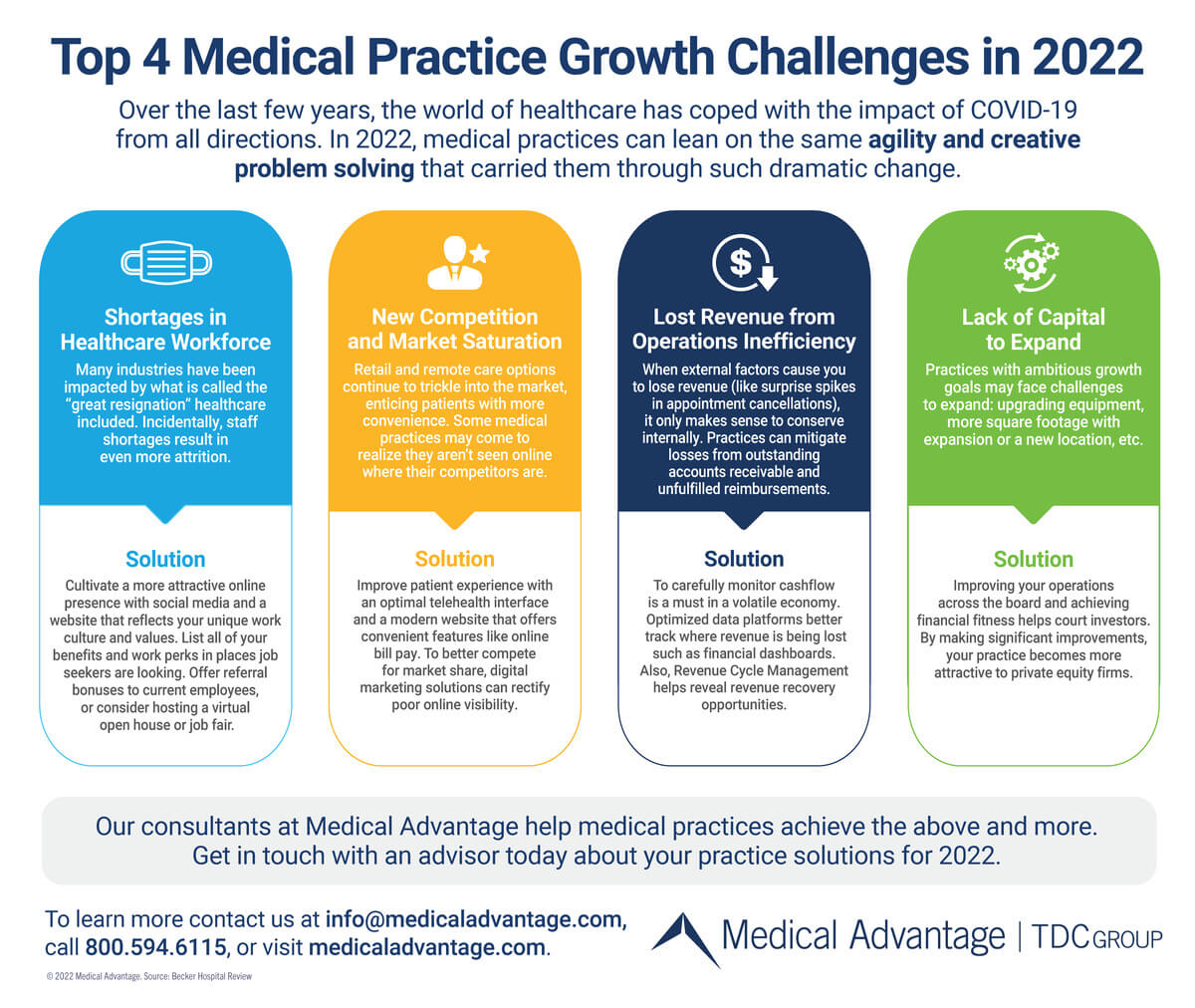Despite 51% receiving COVID relief funding from the CARES Act, 72% of medical practices reported a revenue decrease in 2021. While specialties like behavioral healthcare saw an increase in demand for telehealth services, providers who rely on in-person encounters (such as physical therapy) faced an uphill struggle to help patients.
So, if your organization’s progress does not line up with what you had envisioned by the end of 2021, you are not alone. While so many providers have seen practice growth stunted by the impact of COVID-19, the same creative problem solving that has helped practices survive these grim times can also forge a path to recovery and growth.
Whatever the stage of recovery, growth strategies are integral to rebuilding patient volume and recovering from revenue loss. In this article, we address what challenges are currently hindering healthcare progress and how to grow a medical practice this year.
4 Current Common Challenges of Medical Practice Growth
While medical practice growth challenges are often complex, we focus on the more common ones: staffing shortages, new competitive threats, administrative inefficiency, and a lack of reinvestment funds. When optimization improves performance quality metrics in your operations, this can entice private equity investors who can give you the needed capital to expand.
Challenge 1: Healthcare Workforce
In 2020, one in five healthcare workers left the field, while one in four nurses plan to quit in the next two years. Half of those surveyed say they are considering an exit. What’s more, burnout from worker shortages is a major factor in healthcare employee attrition creating an adverse cycle.
For both positive patient outcomes and to avoid employee burnout, a medical practice is tasked with attracting and retaining needed staff.
Challenge 2: New Competition or Market Saturation
The consumerization of healthcare is now in progress. This means that patients now behave like consumers by choosing a provider the same way they would choose something commercial, such as booking a hotel. They look to reviews and compare which offers are the most affordable and convenient.
Amid this shift in patient behavior, retail and remote care options continue to trickle into the market, enticing patients with hassle-free scheduling, flat fees, and no time spent in a waiting room. The eCommerce giant Amazon is now in the game with its new initiative, AmazonCare. With more care options than ever before, traditional clinics must find creative ways to earn and retain patient loyalty.
Challenge 3: Lost Revenue from Operations Inefficiency
Inefficient report assembly can cause practices to lose track of vital medical operations data. This often occurs when more software systems and new locations are added to a practice. When key metrics are not in order, you lose out on reimbursement opportunities.
The right reporting tools and software, such as healthcare dashboards, and RCM (revenue cycle management) programs can help you keep track of all your clinical, financial, and operational KPIs. The result? Your organization has a better idea of where it stands in key areas ahead of certain deadlines and has the data to maximize reimbursement readily on hand for submission to payers. Our Vice President of Practice Solutions, Chad Anguilm, stresses that your RCM is the key to maximizing revenue: “You can always find the revenue in the rev cycle portion of the business.”
Challenge 4: Lack of Capital
Medical practices with a vision yearn to see their operations improve over time. This may be moving to a bigger facility, upgrading the latest equipment technology, or comprehensive staff retraining. Whatever the next big goal is, there will likely be a fiduciary investment involved.
Aside from maximizing revenue opportunities through better RCM and dashboards tracking, medical practices may wish to seek out multipliers of revenue such as private equity groups. What’s more, well-run practices are more appealing to private equity groups and other would-be investors.

5 Ways Medical Advantage Shows You How to Grow a Medical Practice
Running into the same old issues repeatedly is sure to slow down your practice growth, or even halt it entirely. So, if you have tried making changes and still cannot seem to gain traction, then you are not alone. Many practices lose revenue and precious hours as inefficiency makes workflows difficult to keep up with. Our medical practice solutions experts understand all aspects of how to grow a medical practice by deploying proven methods that clear the path to maximize revenue.
1. EHR Consulting
EHRs (Electronic Health Records) are not one-size-fits-all. In fact, there are hundreds of healthcare software options to choose from. Having so many options available can result in selecting one that fails to meet your needs – for example, an EHR built for family practice is probably not appropriate for a web-based behavioral health provider.
EHR consulting services optimize practice operations to ensure you get the most benefit from your software investment. We configure IT components for maximum interoperability and train practice staff on how to use the EHR more effectively. Optimizing your EHR boosts revenue and improves employee and patient satisfaction.
“A solid technology strategy can make your team more efficient and effective, and pairing the right technology with a team that knows how to do it creates a more efficient practice, thus is going to increase revenue, is going to increase your quality scores, is going to increase patient satisfaction.”
Chad Anguilm
2. Healthcare Dashboards
Without the right data, it is difficult to make the best decisions. Financial dashboards help mitigate this by delivering customized and enhanced practice reports from multiple sources. Having this data up-to-date and organized all in one place allows you to track and assess performance data quickly and easily.
This reporting can include data encompassing scheduling, staffing, accounts receivable, and more. Certain dashboards also feature data warehousing and data aggregation services. Setting up dashboard reporting empowers medical practices that lack IT support, giving them the capability to track KPIs (key performance indicators) which are so important for a practice to prosper.
3. RCM (Revenue Cycle Management)
Perhaps the most powerful tool for medical practice growth in 2022 is an optimized RCM. In this case, our scope is limited to operations efficiency and does not include billing and coding.
Mismanaged AR (accounts receivable) and faulty workflows lead to lost revenue. As mentioned earlier, revenue opportunities are discovered in the RCM. Our experts help you unlock these prospects by optimizing workflows and training staff on best practices. As you maximize revenue, practice growth is inevitable.
4. Telehealth Consulting
Because of COVID-19, “virtual visits” (also referred to as telehealth) have become mainstream and are a permanent pillar of the modern patient experience. Telehealth is yet another symptom of the consumerization of healthcare, as patients come to expect convenience delivered by technology.
Making telehealth an established part of your practice ensures that you can meet healthcare consumer expectations and expand patient care to those who have transportation obstacles. Telehealth introduces its own set of challenges from patient experience satisfaction to cybersecurity and collecting payments. Expert telehealth consultants will help you ensure your patients are cared for remotely in a secure environment by staff who are versed in “virtual visit” best practices.
5. Practice Marketing
When new competitive threats emerge, maximizing medical practice online presence becomes absolutely essential for survival. Patients heavily rely on the internet to find and vet new providers. Even if a practice is ten minutes away, to a patient, this provider does not exist if they do not show up online.
Marketing is a complicated and time-consuming venture, and that is why over 4,000 providers have put our medical digital marketing experts in charge of their online reach. With our proven strategies, practices gain new patients every month.
Aspects of clinic operations mentioned above (EHR, RCM, and telehealth) are familiar to any clinic, but marketing tends to lie outside the scope of core medical operations. To further illustrate how to grow a medical practice through digital marketing, here are a few examples of effective practice marketing techniques.
Have a Modern Website
A Stanford study found that consumers judge the credibility of an establishment by the appearance of its website. While it is unfair to judge a book by its cover, it has become second nature for users to make snap judgments about a medical practice based on aesthetics and ease of use of its website.
Patients also expect medical websites to provide relevant information, answers to their most pressing questions, and convenient amenities (such as online bill pay). A medical practice website designed to serve the patient experience – what they expect and need now – makes the best impression.
Improving Your Online Reputation
Nearly 90% of healthcare consumers take the referrals process one step further by sifting through reviews before booking an initial visit. While you cannot control what patients post online, reputation management for medical providers is the proactive effort that mitigates damage to your online brand – this includes review monitoring and asking satisfied patients to publish reviews publicly.
Cultivating Your Brand Through Social Media
It seems providers only get to connect with patients during phone calls and appointments, but medical practice social media allows you to connect with patients any time. Social media amplifies patient satisfaction to foster consumer confidence. When onlookers see other users positively reacting to social media from a medical practice, they view it as a solid endorsement of your services.
The digital marketing tactics outlined above also help medical practices attract employees. Survey results from Glassdoor and LinkedIn confirm that a positive perception of an employer brand accelerates the recruitment process as many job seekers are more likely to apply when the employer has a well-kept online persona.
Start Designing Your 2022 Practice Growth Strategy Today
A practice growth plan begins by clearing the path of any obstacles that impede your revenue goals. Our team of seasoned healthcare consultants have strong backgrounds in both medical and IT and will design a unique growth plan for practice success. Get started now by filling out the contact form below, and one of our advisors will be in touch soon!



